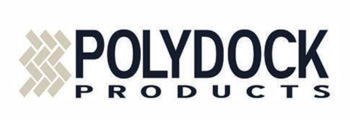Jan 29, 2018
An ice Shove by any name …
Ice Shove, Ice Heave, Ice Surge, or Ice Tsunami, no matter what you call it, they all refer to the same natural phenomena.
First, you need to understand how a pressure ridge forms so please follow this link to this article: https://wisconsinpws.com/ice-pressure-ridge/
The pressure ridge is the usual predecessor of an ice shove.
Having read the article, we need to talk very briefly about the terminology of a pressure ridge.
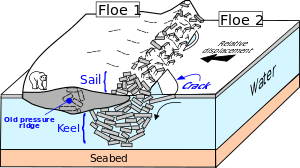
Sample Pressure Ridge
From the previous article, you can see the “rubble” forming the “Keel” of the pressure ridge. After the Keel forms the “Sail” forms above the surface of the ice. When the next strong wind comes along the “sail” will begin pushing against the shore ice. Eventually, some of it will begin to climb over the shore ice and form an ice shove.
When do Ice shoves typically occur?
Ice shoves normally happen during a spell of warmer weather. However, the shove may happen anytime the ice is weakened and then exposed to strong winds.
A shove is more likely to occur the longer the ice is exposed to the winds. The most common time of the year to see this phenomenon is late February and into March although January is not unheard of if a thaw occurs.
The shove occurs when strong winds rapidly push free-floating ice towards or along the shore. Strong winds over time drive areas of ice onshore. As these moving masses of ice travel towards the shoreline, they begin piling up when they encounter resistance from the shoreline or other obstacles. The resulting shove can reach heights of up to 50 feet.
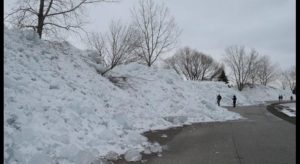
Ice Shove on a Road
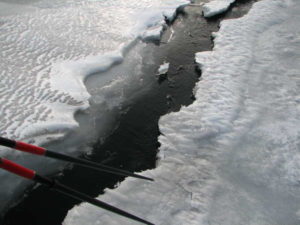
Ice crack before forming an ice pressure ridge
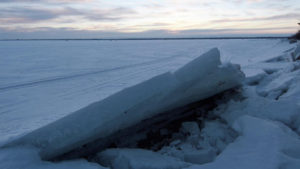
An ice shove beginning
What will an ice shove do to my property?
An ice shove has tremendous power and have been known to push houses off their foundations and uproot large trees and crush seawalls.
Shoreline barriers like trees, seawalls and shallow cliffs do not present any challenge to an ice shove. The ice simply piles up until it flows over the object or simply crushes it. The shove could continue on its journey as long as the winds continue. This depends on the force of the wind and the strength of the ice. One or two properties may be affected while the adjoining properties see no movement at all.
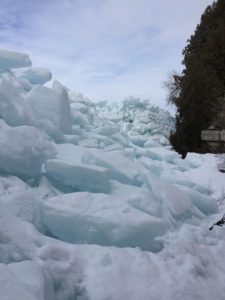
Ice Shove
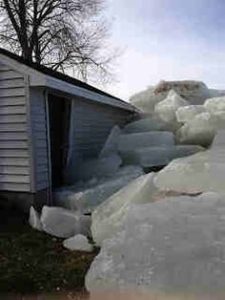
Ice Shove damaging a building
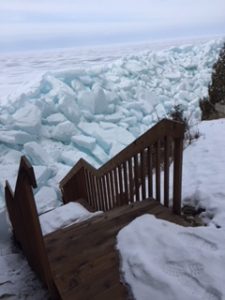
Door County Ice Shove
How do I protect my property?
There is only one thing that you can do – move your waterfront equipment far enough away that the ice normally will not get to it. In doubt? Watch what your neighbors do in Fall. If they have been there for any length of time they know how far back to go to protect their equipment in a normal year. Our crews remove equipment in Fall and have a good idea where it has to go also.
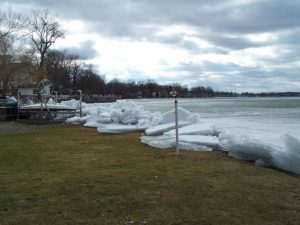
Ice Shove
What does Pier and Waterfront Solutions do to protect equipment?
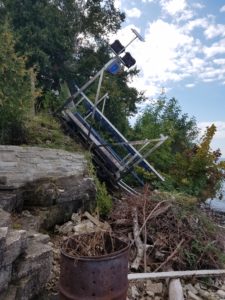
Lift Removal to escape an ice shove
With little or no shoreline, here’s an example of what PWS does to prevent damage to your equipment. The lift and dock had to be raised to the top of a ledge to avoid damage.
How big are Ice Shoves?
Ice Shoves sometimes affect a small area of shoreline all the way up to vast distances. This ice shove affected just one property while the neighbors had no damage.
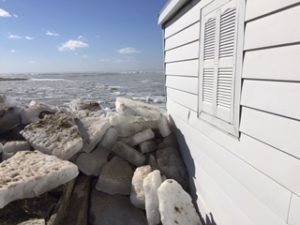
Door County Ice Shove -2017
For more information check this video to see an actual ice shove in action: https://www.youtube.com/watch?v=Pf5pWz7uRt4
Reminder
Pier & Waterfront Solutions specializes in ShoreMaster docks, lifts, and accessories both residential and commercial. We service the rest.
PWS is located in the center of Door County at 7325 St Hwy 57. Located 1 mile North of County MM (Hwy 42) and South of Sturgeon Bay at the intersection of Idlewild Road. Our staff is ready to help you anytime.
Want us to address a dock or boat lift topic for you? Feel free to give us a call.
Call Jerry at 920-493-4404 or email him at Jerry@wisconsinpws.com for more information.
Jan 25, 2018
What causes an Ice Pressure Ridge?
An ice pressure ridge results from a change in temperature which causes the ice to crack.
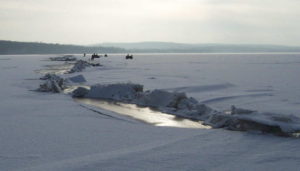
Ice Pressure Ridge – Door County
This forms a floating sheet of ice. When an area of open water is present the sheet of ice is able to move freely.
Think of an ice cube when you first put it into a glass of water. When exposed to the warmer water the ice cracks at the weakest part.
Where Does the Pressure Ridge Start?
A pressure ridge usually starts a few hundred feet off the shoreline in what would be 2-3′ of water in the summer. Up to this point, the ice is anchored to the bottom of the lake. The ice near the shore remains very stable and does not move from the shoreline.
Water begins at this point under the ice. The water gets deeper as you go out. Much like an ice cube, the ice will “crack” when exposed to pressure from winds or warmer temperatures.
If you have ever been on or near the ice in winter, you have heard the ice “crack”. The wind is generally blowing at these times or the ice may have been exposed to warmer temperatures. The ice builds up pressure at the open-water mark. The ice separates and “cracks”. This sound can travel for miles.
The pressure ridge may form anywhere there is thin or weak ice.

Ice crack before forming an ice pressure ridge – Door County
How does the Ice Pressure Ridge form?
With the ice near the shore securely anchored to the shoreline and the bottom, the floating ice on the outer side of the crack moves away from or along the shore with the wind. If the direction of the winds changes it moves
With the ice at the shore anchored to the shoreline, the floating ice on the outer side of the crack moves away from or along the shore with the wind. When the direction of the winds changes it moves back to the joint or along the joint again.
When the floating ice hits the stationary ice on the shore, pressure builds up and crushes the edges into pieces called “rubble”.
Some of the “rubble” sinks to the bottom due to weak ice under the top layer. This rubble forms the “keel” of an ice pressure ridge. The loose “rubble” continues to accumulate under the main shelf of ice until it hits the lake bottom.
When the “rubble” hits the bottom there’s no place for the “rubble” to go – except vertically. Now the accumulating rubble forms the “sail” on the upper part of the pressure ridge. The “sail” can be anywhere from inches high to 50 feet high depending on the winds and the strength or weakness of the ice.
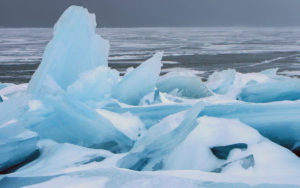
Ice Pressure Ridge
When the “rubble” hits the bottom there’s no place for additional “rubble” to go – except vertically. Now the accumulating rubble forms the “sail” portion or upper part of the ice pressure ridge. The “sail” can be anywhere from inches high to 40 feet high depending on the winds and the strength or weakness of the ice.
How fast does the Pressure Ridge form?
A pressure ridge usually forms rapidly when the winds are blowing strong and steady. You need to be especially careful when approaching the pressure ridge because you don’t know how much solid ice remains.
Since the “rubble” below has been exposed to non-freezing temperatures, it starts to melt away. This results in a weak and fluctuating joint at the surface. The area around the ice ridge can be very dangerous.
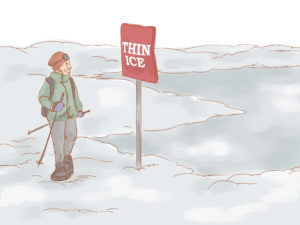
Warning – Thin Ice
Are there other signs of weak ice?
Slow melting ice will result in dark areas which means the water on top and below the ice is melting the ice away. Never go on this type of ice as it is very weak. Be careful around pressure ridges, they indicate the presence of weak ice.
Ever wondered what causes ice shoves?
See our next article on January 30th for an explanation.
Reminder
Pier & Waterfront Solutions specializes in ShoreMaster docks, lifts, and accessories both residential and commercial. We service the rest.
PWS is located in the center of Door County at 7325 St Hwy 57. Located 1 mile North of County MM (Hwy 42) and South of Sturgeon Bay at the intersection of Idlewild Road. Our staff looks forward to assisting you.
Want us to address a dock or boat lift topic for you? Feel free to give us a call.
Call Jerry at 920-493-4404 or Email Jerry@wisconsinpws.com for more information.
Nov 28, 2017
Jet Ski Lift Platform
A Jet Ski Lift platform is the latest development of Pier & Waterfront Solutions. These stainless steel loading platforms are made exclusively for the ShoreMaster SM 1064 and SM 1264 Jet Ski Lifts by PWS.
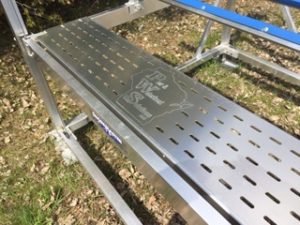
Jet Ski Lift Platform
The jet ski Lift platform kit consists of a stainless steel, perforated platform that mounts securely to the lift rack.
- No need to drill holes and risk damage to the cables inside.
- The platform never rots.
- Simple to install – one 9/16” wrench is all you need.
- Stainless steel platforms provide a stable loading or working platform.
- The walk platform allows easy access to both sides of the Jet Ski – in or out of the water.
Additional benefits
- It allows you to put a cover on your Jet Ski while high and dry.
- Why scramble over your jet ski to put a cover on?
- No more getting tossed around by waves while trying to work.
- No more trying to stand on the lift rack and risk falling or injury.
Imagine being able to service your jet ski without having to stand in the water. Now you have a loading platform to set your equipment on when working on the engine or re-fueling your unit. You can do all kinds of work and stay dry.
How About another Great Idea?
Also offered by Pier & Waterfront Solutions – a Jet Ski winch extension post kit.
The extension post kit allows you to move the winch higher on your ShoreMaster lift post. Now you have better access to the wheel from the dock – even if the dock is above the lift wheel. No need to lie on the dock in order to reach the wheel.
Reminder
Pier & Waterfront Solutions specializes in ShoreMaster docks, lifts and accessories both residential and commercial. We service the rest.
PWS is located in the center of Door County at 7325 St Hwy 57. It is located 1 mile North of County MM (Hwy 42) and South of Sturgeon Bay at the intersection of Idlewild Road.
See a complete list of articles at “News” on our website.
Want us to address a dock or boat lift topic for you? Feel free to give us a call. We believe that an informed consumer makes better decisions.
Call Jerry at 920-493-4404 or Email Jerry@wisconsinpws.com for more information.
Nov 21, 2017
Boat Lift Canopy Maintenance
Boat lift canopy Care will provide you with years of service, if properly used and maintained.
Proper maintenance is important in the Fall
Boat Lift Canopy care is an important step to extending the life of your canopy. As the air gets cooler and the days shorter, the leaves begin to turn colors. You know what’s ahead. You can hope for more sunny, warm days but we know that nature is in total control.

Fall Foliage
We also know there are some things we need to do to maintain our docks, boat lifts and accessories. It’s more than simply moving the equipment up on the shore. Protecting the equipment from the ice is just the beginning of what should be done.
Note – It should be pointed out that while PWS does remove and store your boat canopy in your designated spot as part of our removal service, canopy cleaning is not part of the service due to the length of time it takes to clean and thoroughly dry the cover as explained below. The process can take a full day to be done properly. After cleaning the canopy it must be thoroughly dried before storage.
What steps do I need to follow with a Boat Lift Canopy?
Follow these simple rules to get the maximum life from your canopy.
1. Always avoid allowing water to puddle on the canopy for extended periods of time during the season. Water, excessive bird droppings and dirt cause discoloration.
2. It’s important to keep the canopy free of battery acid and tree sap. These may corrode and eat holes in the canopy.
3. Always fold and store the canopy ONLY when completely dry. Wet or damp vinyl will discolor and form mold/mildew if stored in that condition. Storage in a warm, dry location will extend the life of your canopy.
4. If stored in a bag make sure it is breathable. Do not use a plastic bag. Moisture will be trapped inside and mold or rotting will occur.
5. DO NOT use chemicals or abrasives to clean a boat lift canopy. This could damage the vinyl. Use a soft cloth, mild dish soap (like Ivory) and water for best results.
6. Of course, Do Not get too aggressive when cleaning bird droppings from the vinyl cover. You may wear the protective finish off in that area or tear the vinyl.
7. If weather is threatening, keep the boat on the lift. Without the weight of the boat to hold it down the lift could be flipped over by the canopy.
8. The boat lift canopy must be removed when taking the boat lift out of the water for any reason. Failure to do so could result in wind damage to the canopy, boat lift and surrounding equipment.
9. Additionally make sure the boat lift canopy is completely dry before storing it. This will prevent mold and mildew from ruining the canopy. Those autumn leaves are beautiful but if left wrapped in your canopy they will permanently discolor your canopy cover.
CAUTION: A Vinyl canopy is removed by detaching hooks. Stretching and removing bungee cords requires strength and proper balance. DO NOT let release the bungee cord when under tension. An eye injury or other bodily injury could occur. ALWAYS wear safety glasses and the proper protective clothing.
Boat Canopy Care
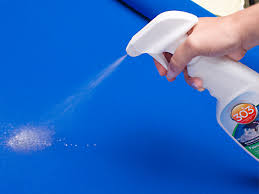
Boat Lift Canopy cleaning
The cleaning and proper storage of your boat canopy requires some basic supplies and steps to ensure the longevity of your cover.
The first step is to ensure that any product that you use is safe for your canopy material. If you must use a chemical to clean your canopy, be sure it does not contain any ingredients that will stain, corrode, or otherwise damage the material.
The next step is to remove the canopy from the lift. Once removed, spread the canopy out on a flat clean surface – grass is fine. You need to avoid damp or freshly mowed areas as this may increase the work you end up doing. (Remember to remove any cut grass, etc from the bottom of the canopy before folding for storage
PREFERRED METHOD; Use a gentle dish detergent and warm, soapy water and a soft bristled brush to gently clean the surface. Rinse well and allow the boat canopy to dry thoroughly.
Boat Lift Canopy Storage
After thoughtfully drying it, store the boat canopy by carefully folding the canopy in on itself several times until it resembles a strip 18”-24” wide and then roll the canopy into a roll that is manageable. Many canopies will come with their own storage bag but if yours did not, take care not to store the canopy in a plastic or otherwise un-breathable material. Remember – It MUST breathe through the winter.
DO NOT roll the canopy cover so tight that it can not breathe and DO NOT put a sharp crease in the material. The canopy should be allowed to “rest” in a protective bag or box that allows for proper air movement. If the bag does not allow the canopy to breathe, moisture could accumulate and promote molds and mildew in the off season, ultimately making your canopy’s life-span shorter.
Do not store on the floor where moisture can accumulate under the bag or box.
You should avoid binding the boat canopy for storage and never use duct tape to keep the canopy bundle together as the glues used are difficult to remove. Binding the canopy for long periods could promote intense creasing that may eventually lead to splitting of the canvas.
The stitching and seams that hold your canopy together should be kept as clean and dry as possible to avoid the failure of these areas from exposure to moisture, mold and dry-rot as the years roll by.
Prevent small animals (squirrels and mice) from getting into the rolled material. They can cause stains and premature product failure if allowed to set up housekeeping in your cover.
What about the Canopy Hardware?
Bungees, springs, cords, straps, etc., should be stored in a SEPARATE bag and kept with the canopy to avoid misplacement of the hardware and unintended damage to the canopy by these items. If rolled into the fabric layers for storage, moving the bundle can wear through the fabric and accidentally punch holes in it.
Remember
Pier & Waterfront Solutions (PWS) specializes in all ShoreMaster docks, lifts and accessories.
Located in the center of Door County at 7325 St Hwy 57, just south of Sturgeon Bay at the intersection of Idlewild Road. Our staff looks forward to serving all of your waterfront needs year round.
Equally important, if you found this article helpful – Go to “NEWS” on any page of our website for a complete list of articles. These articles are meant to keep you informed on the latest product information and maintenance issues. Check out our “older entries” also.
The wide variety of articles on dock and boat lifts issues will answer many of your questions. PWS believes that an informed consumer makes better decisions.
Call Jerry at 920-493-4404 or Email Jerry@wisconsinpws.com for more information.
Nov 14, 2017
Boat Lift Motor Care for a Wheel Driven Boat Lift
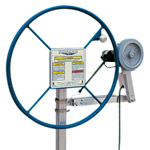
ShoreMaster Lift Mate
Boat Lift motor care for a rubber, wheel-driven motor, consists of a few simple steps for storage.
In general, it’s important to understand how the drive works.
How does a Boat Lift Motor work?
The Shore Master “Lift Mate” motor shown here, applies pressure to the outside of the large hand wheel. The tension is applied by the use of a bungee cord. A flip of the motor switch is all it takes to raise or lower the boat without any effort. These are generally powered by a solar arrangement. AC driven units are also available. You never have to turn the wheel by hand again.
However, this simple boat lift motor setup requires some common sense care for the winter..
For winter storage you have a choice:
First, you can release the bungee cord and remove the motor assembly arm completely by removing the large pivot arm bolt on the mounting assembly. Then, store the motor in a building for the winter.
or
For a Second choice – relieve the tension on the bungee cord. Then, leave the motor in place. This will prevent a a flat spot from forming on the rubber wheel over the winter. If you use this step – Do not rotate the motor down.
NOTE: The bungee cord has a lot of tension on it. For this reason – handle it with caution. Eye protection is recommended. The cord can slip out of your hand, causing the hook on the end to hit your hand, arm or eye. Grip it firmly. The same is true when re-attaching the bungee cord and hook in the Spring.
Remember, if you choose option 2, release the tension on the bungee cord BUT DO NOT rotate the motor arm down. Leave it in the operating position for the winter. Rotating the motor down will allow moisture to seep into the motor casing. This will cause a build up of water inside the motor which will prematurely damage or short out the motor when power is re-applied.
Similarly, DO NOT wrap the lift motor in a plastic bag for the winter. Moisture from condensation or rain and melting snow has been known to fill the bag with water with disastrous results.
An alternative to the Wheel-Driven Boat Lift Motor
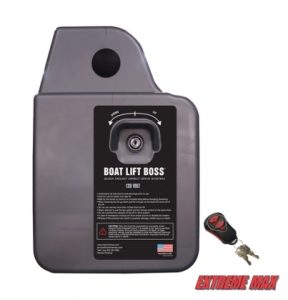
Lift Boss
An better alternative to a wheel driven motor drive is the Lift Boss motor. With this type of motor the large wheel is removed completely. This boat lift motor is generally driven by solar energy with an A.C. model available. The motor can be left exposed to the elements year round. There is no bungee cord to remove and no slipping when the wheel is wet from rain or the morning dew.
The housing allows moisture to escape without fear of damage to the motor.
For more information about boat lift motors see also https://wisconsinpws.com/lift-boss-motor-hard-raise-boat/
Remember
Pier & Waterfront Solutions (PWS) specializes in all ShoreMaster docks, lifts and accessories.
Located in the center of Door County at 7325 St Hwy 57, just south of Sturgeon Bay at the intersection of Idlewild Road. Our staff looks forward to serving all of your waterfront needs year round.
Equally important, if you found this article helpful – Go to “NEWS” on any page of our website for a complete list of articles. These articles are meant to keep you informed on the latest product information and maintenance issues. Check out our “older entries” also.
The wide variety of articles on dock and boat lifts issues will answer many of your questions. PWS believes that an informed consumer makes better decisions.
Call Jerry at 920-493-4404 or Email Jerry@wisconsinpws.com for more information.





















